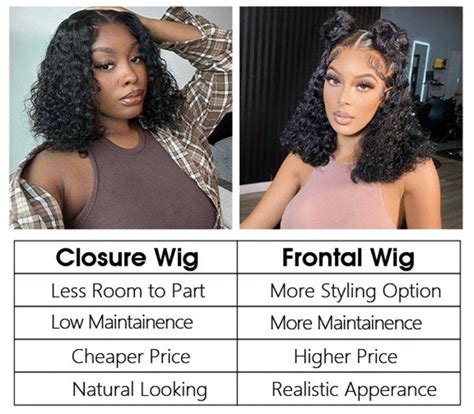Understanding the Difference
Frontals and closures are essential components of protective hairstyles, offering seamless extensions and versatility. However, understanding their key differences is crucial to make an informed decision.

1. Coverage Area
Frontals consist of a lace base that covers the entire hairline, extending from ear to ear. They provide a natural-looking hairline and can be styled in various ways. Closures, on the other hand, cover a smaller area, typically ranging from 4″x4″ to 6″x6″. They are designed to conceal the leave-out area or create a part.
2. Lace Material
Frontals and closures can be made from different types of lace, including transparent lace, HD lace, and Swiss lace. Transparent lace is the most affordable option, while HD lace and Swiss lace are known for their delicate and barely-there appearance. The choice of lace depends on personal preference and budget.
3. Installation Method
Frontals require a more intricate installation process than closures. They are typically sewn or glued directly to the hairline, providing a secure and long-lasting hold. Closures are easier to install and can be attached using clips, tape, or sew-in methods.
4. Styling Options
Both frontals and closures allow for a wide range of styling possibilities. They can be parted, styled with different hair textures, and adorned with accessories. Frontals offer greater versatility as they provide coverage from ear to ear, allowing for more complex hairstyles.
5. Pricing and Maintenance
Frontals tend to be more expensive than closures due to their larger size and coverage area. They also require more maintenance, as the entire hairline must be cared for and stylized. Closures are more affordable and require less maintenance, but they may offer limited styling options compared to frontals.
Benefits and Drawbacks
Frontals
Benefits:
* Natural-looking hairline
* Covers the entire forehead
* Allows for various styling options
* Long-lasting hold
Drawbacks:
* More expensive
* Requires more maintenance
* Can be difficult to apply
Closures
Benefits:
* Affordable
* Easy to apply
* Low maintenance
* Offers a natural part
Drawbacks:
* Smaller coverage area
* Limited styling options
* Requires a leave-out area
Which One is Right for You?
The choice between a frontal and a closure depends on individual preferences and needs. If you prioritize a natural-looking hairline, versatility, and long-term coverage, a frontal may be the better option. If you prefer affordability, ease of installation, and low maintenance, a closure may be a suitable choice.
Step-by-Step Installation Guide
Frontal Installation
- Prepare your natural hair by washing, conditioning, and blow-drying.
- Cut the lace around the hairline to create a seamless transition.
- Apply the frontal using a glue or sewing method.
- Style the frontal to your desired look.
Closure Installation
- Prepare your leave-out area by braiding or cornrowing.
- Cut the closure to fit the leave-out area.
- Attach the closure using clips, tape, or a sew-in method.
- Blend the hair on the closure with your own hair using heat styling tools.
Tips and Tricks
- Research different lace types and choose the one that best suits your skin tone and hair texture.
- Practice applying the frontal or closure before doing the actual installation to avoid any mistakes.
- Use high-quality glue or tapes to ensure a secure hold.
- Moisturize the lace regularly to prevent damage and ensure longevity.
- Avoid using harsh products or heat styling tools directly on the lace.
Conclusion
Frontals and closures offer unique advantages and disadvantages. By understanding the key differences, you can make an informed decision that best meets your individual needs. Whether you prioritize a natural-looking hairline or ease of installation, both frontals and closures can elevate your protective hairstyles to the next level.
